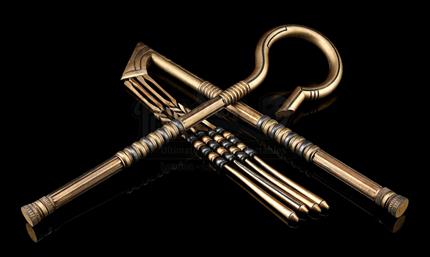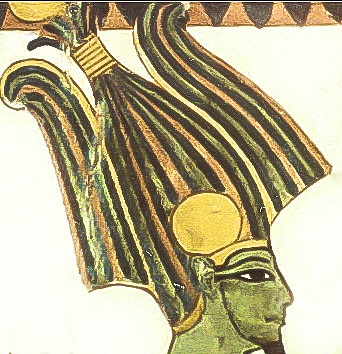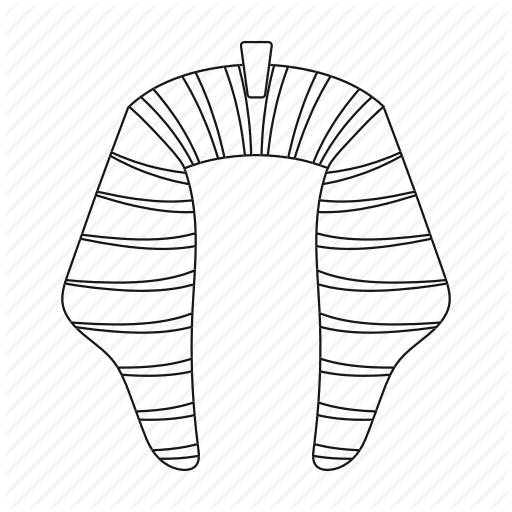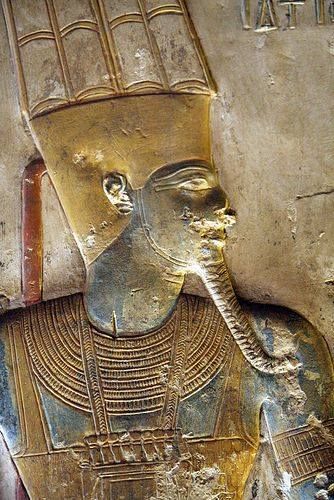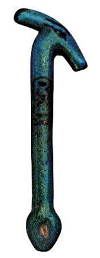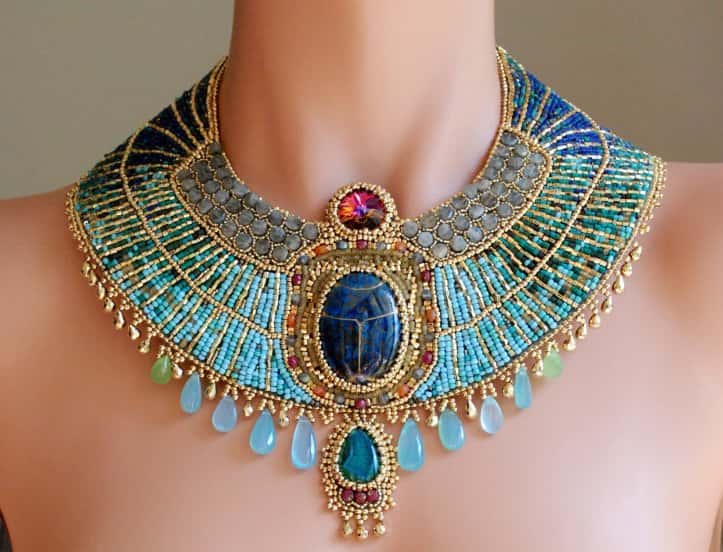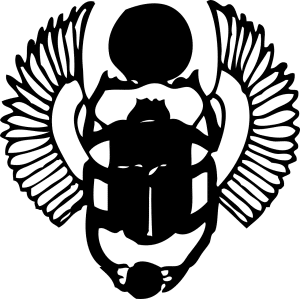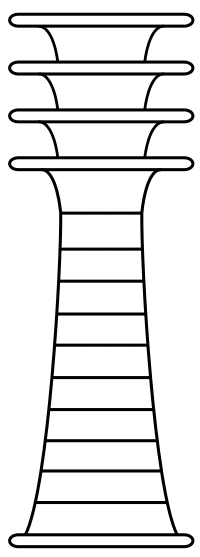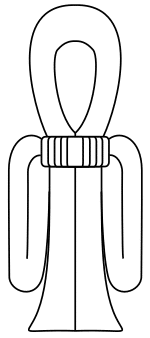Crowns
Undoubtedly, the best-known element of costumes of the Egyptian pharaoh was their own crowns, of which there were numerous examples. The most common and best known are:
1- The Hedjet Crown or White Crown , symbol of Upper Egypt.
2- The Desheret Crown or Red Crown , symbol of Lower Egypt.
3- The Crown Sejemty or Double Crown, symbol of unified Egypt, is a superposition of the two previous crowns.
4- The Atef Crown or Osiriaca Crown , present in some funerary rituals. Precisely, the funerary cult was the sphere of influence of the god Osiris.
5- The Crown Khepresh or Blue Crown , of still dark meaning, but very used from the New Empire.
6- The Shuty Crown or Plumed Crown , which eventually came to be used by the Great Royal Wives and the Divine Adorers .
7- The Crown Hemrem or Triple Atef , composed of three Atef crowns and some accessories; It seemed to have a solar function.
Crook and flail
Originally linked solely to the god Osiris, the crook and flail later became a combined symbol of pharaonic authority.
The shepherd’s crook stood for the power and responsibility of kingship, while the flail was shorthand for the fertility of the land.
Ankh
The ankh, which is usually grasped in the left hand of a pharaoh, is one of the most important symbols associated with the pharaohs.
It represents the concept of eternal life; a state of being that was close to the hearts of the pharaohs, as represented by their tombs and monuments. The ankh also represents religious pluralism (all gods as one).
The ancient Egyptians had the belief that the gods had dominion over eternal life.
For this reason, the representations of their gods with the Ankh symbolized their power over life and death.
Many times the gods were represented holding an Ankh by its loop with their hands. It is also usual to represent the gods with folded arms and an Ankh in each hand held by its lower end.
Also common are representations in which a god holds the Ankh near the lips of a pharaoh. This symbolizes the offering by the gods of the breath of life, necessary for the afterlife.
The ancient Egyptians also considered the Ankh an amulet that they carried with them. They also manufactured Ankh-shaped mirrors to represent the mutual reflection between life and death.
Nemes headdress
Less of a crown and more of symbol of a pharaoh’s power, the nemes was a headdress that covered the whole crown, the back of the head and the nape of the neck. Usually striped with gold (to represent the ruler’s wealth), the nemes had two large flaps that hung behind the hears and draped over the front of the shoulders.
False beard
Like Osiris, the pharaoh is also going to wear it. However, it must be said that this beard was not always the same.
When Pharaoh was alive, he represents himself straight, without braiding. However, when the pharaoh is represented already deceased, the beard appears braided, like that of Osiris.
The Egyptian symbols were used during different periods of Egyptian civilization to represent all kinds of concepts and ideas of its religious or cultural tradition.
Many of these symbols were related to some Egyptian god. The Egyptians used these symbols to decorate their temples, to represent their gods in their inscriptions and to make amulets to cope with difficulties.
Was
“Was” is a scepter characteristic of male deities. It was an amulet that symbolized dominance, power and strength. Its shape was that of a straight rod with the head of an animal and lower end bracketed. It can be seen sometimes accompanied by the Ankh cross and the Djed pillar.
Uraeus
Uraeus: It is a representation of the goddess Uadjet symbol of royalty. It constituted a protective emblem of the gods and pharaohs.
It used to be accompanied by a representation of the goddess Nekhbet and placed in the headdress of the pharaoh.
Uadjet was the protective goddess of Lower Egypt, while Nekhbet was the protective goddess of Upper Egypt, therefore, when the two were placed in the headdress of the pharaoh, they symbolized the sovereignty he had over the two lands.
Udjat or wedjat: Eye of Horus
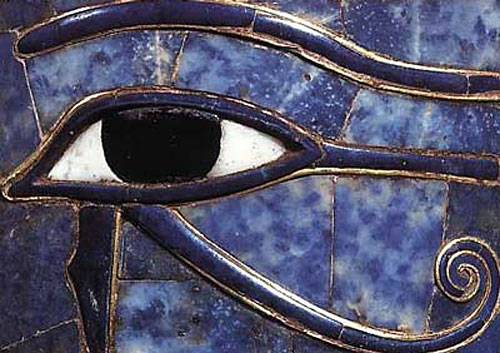
Udjat or wedjat. The left eye was attributed to the Moon, and is basically called Eye of Horus. While his right eye was attributed to the Sun, it was also called Eye of Ra.
Udjat or wedjat: It is better known as the Eye of Horus and was the most popular amulet used in the ancient Egyptian civilization.
It was a symbol to which protective, magical, purifying and healing qualities were attributed.
Specifically, they considered that it pondered and protected eyesight, counteracted the effects of the evil eye, protected the deceased and granted prosperity and health to those who wore it.
The symbol comes from the god Horus, the god of heaven represented in the form of a hawk or a hawk- headed man.
According to ancient Egyptian religion Osiris, the father of Horus, was killed by his brother Seth. Horus sought revenge and in a series of encounters with Seth lost his left eye.
The god Thoth, god of magic and wisdom, was able to restore the eye of Horus and this in turn offered the eye to Osiris to restore his life. For this reason, the eye of Horus could also symbolize sacrifices, recovery, and protection.
The two eyes of Horus have a special symbolism in ancient Egyptian religion. Traditionally his right eye was associated with the Sun, while the left eye was associated with the Moon.
This left eye was mostly known as the eye of Horus, while for the right eye the name of Ra’s eye was used, since Ra was the sun god. Although the two eyes are different symbols they refer to very similar concepts.
It was also a customary tradition among ancient Egyptians to make funerary amulets in the shape of the eye of Horus.
Read more: Photos of lavish pieces of ancient Egyptian jewelry
Scarab Beetle
The scarab beetle is an Egyptian symbol linked to the god Khepri, the movement of the sun god seen as one of the possible forms of the sun god Ra.
Scarab beetles lay their eggs in dung balls, which they then put in some hole in the ground.
This led the ancient Egyptians to think that these beetles were self-reproducing and equated this property to that of the god Khepri, who is reborn every day as the Sun.
For this reason, the beetle within the ancient Egyptian world can be understood as a symbol of the rising Sun.
The ancient Egyptians made all kinds of beetle-shaped amulets, known as scarab, to symbolize the Sun, the resurrection and obtain their protection both in life and in death.
They also made funerary amulets in the form of a beetle. In this case they used to be bigger and with hawk wings.
These amulets were placed over the deceased’s heart to protect him on his journey to the underworld.
Djed Pillar
The djed pillar is one of the oldest symbols of ancient Egyptian religion. It symbolizes strength and stability and is related to the creative god Ptah and Osiris, the god of death.
Due to its association with the god Osiris this symbol is also known as the backbone of Osiris.
The ancient Egyptians often made amulets in the shape of the djed pillar symbol. These were for both the living and the dead.
It was also customary to decorate the bottom of the coffins with an engraving following the shape of the djed pillar, centered on the same space where the deceased’s spine would be placed.
Tyet
This symbol, also known as knot of Isis, is an ancient Egyptian symbol that represents the goddess Isis.
This is a symbol of unknown origin but that has a certain geometric similarity with the Ankh symbol.
Also its meaning is similar to that of Ankh since it is considered that the tyet symbolizes life and well-being.
The designation of knot of Isis has its origin in the similarity of this symbol with the knots used to hold the dresses of the gods.
This symbol is often accompanied by the Djed Pillar, symbol of the death god Osiris.
This has led some experts to interpret this joint representation as a symbol of the duality between life and death.

